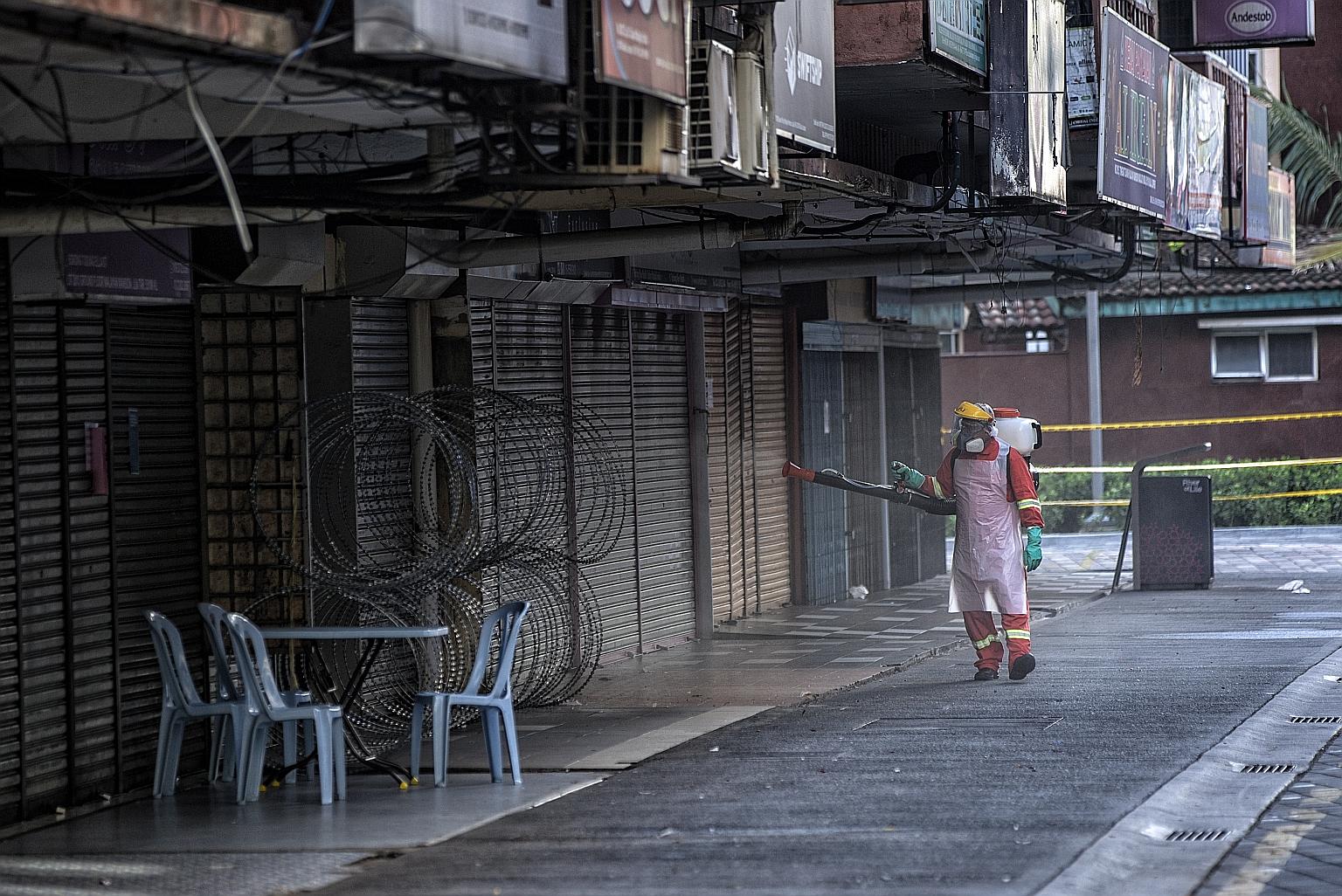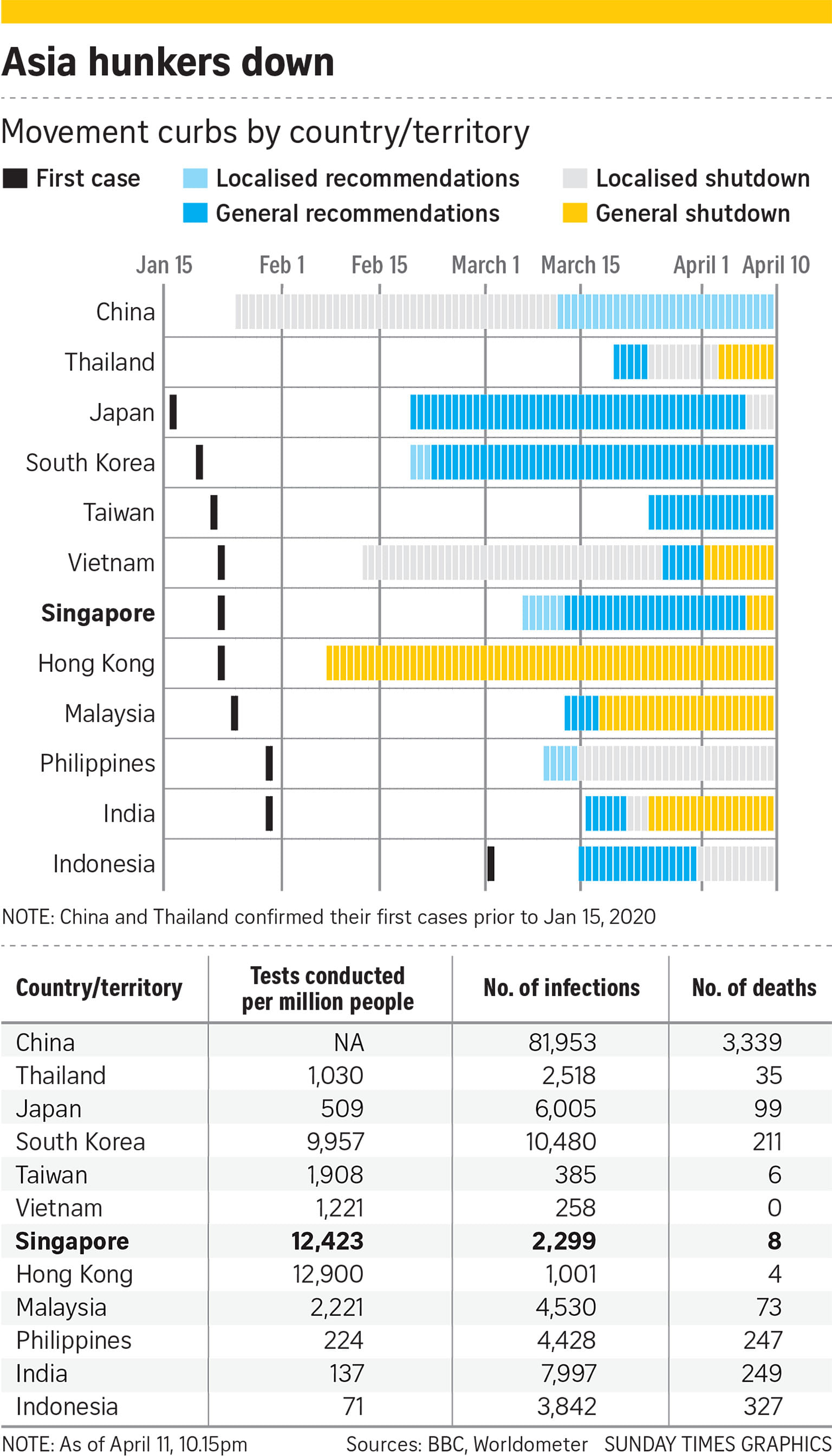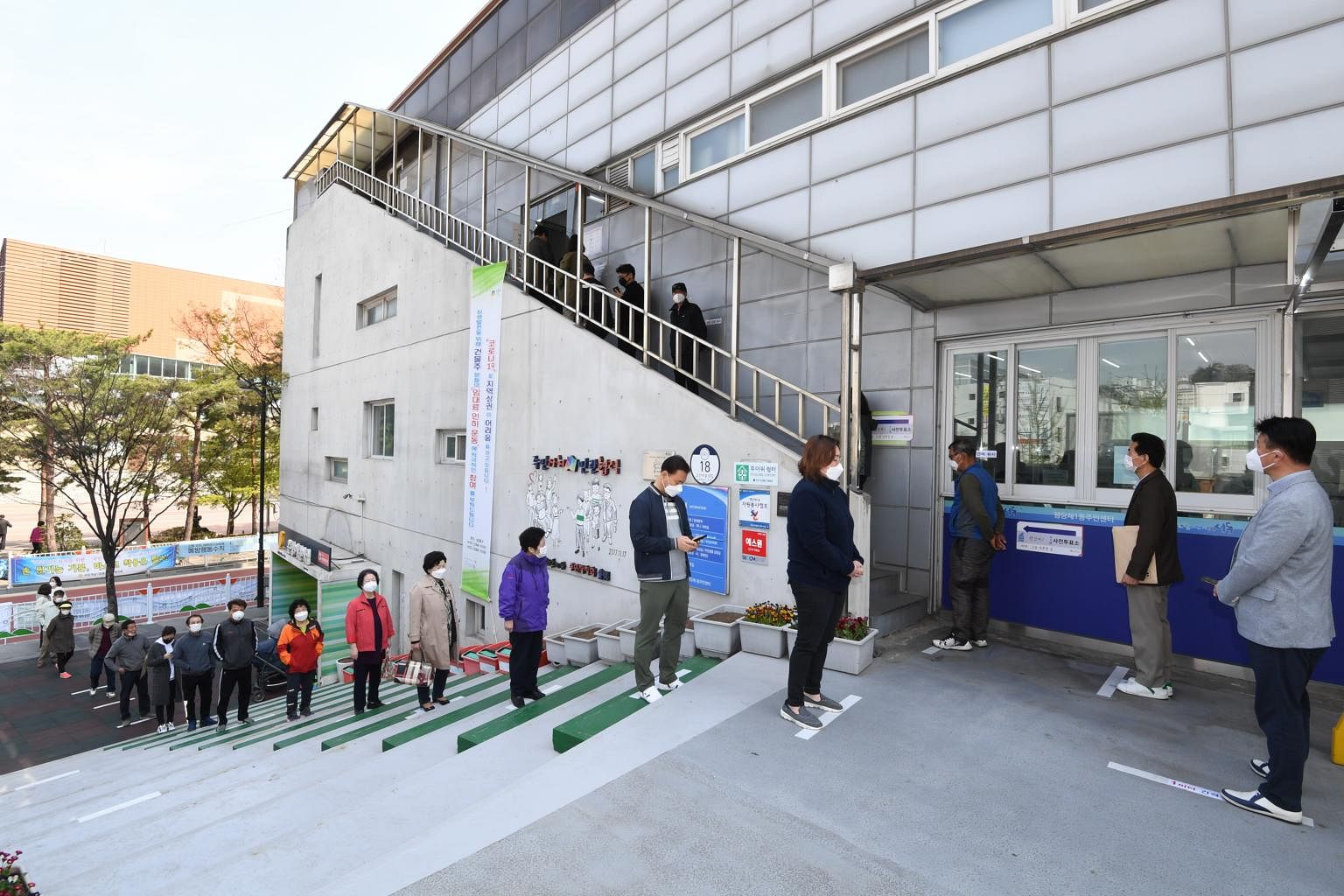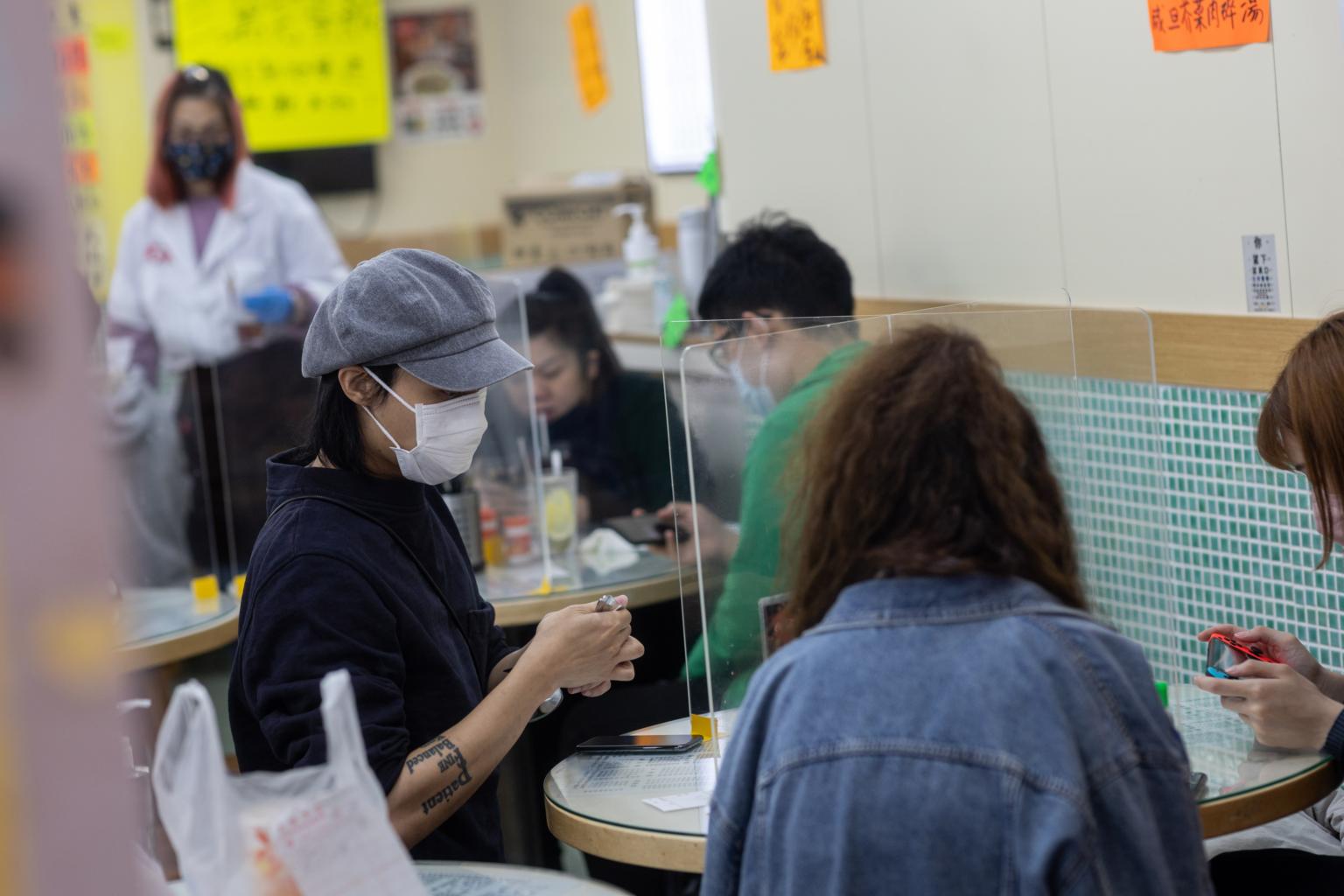COVID-19 SPECIAL
Coronavirus: How S'pore's circuit breaker compares with other countries' lockdowns
Across Asia, actions taken range from gentle guidelines to sweeping curbs on movement
Sign up now: Get insights on Asia's fast-moving developments

A worker sprays disinfectant near a district categorised as a red zone area in Kuala Lumpur on April 8, 2020.
PHOTO: EPA-EFE
Magdalene Fung Assistant Foreign Editor, Magdalene Fung
Follow topic:
Call it a movement control order, curfew or a lockdown. Around the world, governments have imposed increasingly stringent social distancing measures to curb the spread of the coronavirus as it continues its global rampage.
Across Asia, these actions range from aggressive nationwide lockdowns to gentle guidelines encouraging people to stay home.
In Singapore, the Government has so far refrained from a total lockdown, describing its orders to shut almost all workplaces and schools as a "circuit breaker". The term conveys the desired outcome - to break the chain of transmission and stem the spread of the deadly disease - rather than the restrictions on its people.
The tightened measures, which kicked in last Tuesday, came after a significant surge in locally transmitted infections, many of which could not be traced to their sources. The spike occurred after swathes of Singaporeans working and studying in Europe and the United States returned home amid a worsening outbreak in those regions. Before that, Singapore had already shut entertainment venues, scrapped extracurricular school activities and limited numbers in restaurants, malls and social gatherings, among other distancing rules.
The circuit breaker measures - set to last until at least May 4 - include a ban on dining out and instructions to limit social contact to members of the same household. To press home the point, the Government passed a new law last week, temporarily banning all social gatherings, with Prime Minister Lee Hsien Loong warning that it would be strictly enforced. Penalties for first-time offenders involve fines of up to $10,000 and six months' jail.
PROGRESSIVE MEASURES
Singapore's circuit breaker bears similarities with gradated shutdowns in other Asian nations.
Malaysia imposed a nationwide movement control order in mid-March, banning public gatherings, shutting schools and closing businesses except for certain categories of essential services until March 31. That order was extended twice, until April 28, with the number of businesses allowed to stay open whittled down further before restrictions were relaxed slightly on Friday.
Like Singapore's new law - which bestows the Health Minister with the power to shut premises and restrict individuals' movement - Malaysia also introduced an "enhanced movement control order" that grants its authorities the right to seal off areas of infection, close almost all businesses and keep residents at home for two weeks.

In Indonesia, the country's partial lockdown reflects competing priorities between its central and local governments that have hampered a unified progressive approach. Indonesian President Joko Widodo has been resisting a nationwide lockdown even as some regional leaders try to restrict movement within their provincial borders.
The authorities in Central Java closed the province to visitors until the end of July, while Papua province shut its ports and airports to commercial travellers.
Although Jakarta accounts for most of Indonesia's coronavirus cases, stricter measures - including school suspensions, workplace closures and shorter public transport operating hours - kicked in for the capital only on Friday. Its governor has accused the central government of stonewalling his efforts to impose a partial lockdown on the city.
Mr Joko has insisted that cities across the country should not impose border lockdowns, arguing that the country's poorest would be the biggest losers if the economy grinds to a halt, and the government would subsequently be hard-pressed to provide for them. Local governments, however, are more inclined to focus on avoiding further infections and deaths within their loci of authority.
To be sure, Indonesia's sheer size - with its 34 provinces and more than 270 million people - makes it a tough country to govern and a potential hot bed for bureaucracy.

SWEEPING LOCKDOWNS
While governing a huge country can complicate coronavirus policy coordination efforts, authoritarian China appears to have done well in this aspect, with local officials springing into action after its President Xi Jinping ordered an all-out "people's war" against the disease.
It shut down Wuhan where the outbreak originated and other big cities in the central Hubei province on Jan 23, after disclosures of the first hundreds of infections. Other cities - including eastern Zhejiang's Wenzhou, far from Wuhan - soon followed, putting hundreds of millions of Chinese people under some form of movement restriction. More than two months on, local media are still reporting new lockdowns across the country amid fears of a second wave of infections, including in Henan's Jia county, Heilongjiang's Suifenhe city and Shandong's Jiaozhou city.
The strict quarantine measures worked, with cases slowing to a trickle until March 19 heralded the first day since the outbreak began that no new infections were reported in Hubei. Wuhan started reopening last Wednesday.
A study published in the international journal Science last month attributed a delay in the spread of the virus to China's decision to lock down the city. "Our analysis suggests that without the Wuhan travel ban and the national emergency response, there would have been more than 700,000 confirmed Covid-19 cases outside of Wuhan by (Feb 19)," Oxford fellow Christopher Dye, one of the paper's authors, told Agence France-Presse. There were 30,000 cases in China on that date.
Another big Asian nation in strict lockdown is India, which has ordered its 1.3 billion people to stay indoors until April 14, with an extension being deliberated. The three-week lockdown has suspended all schools, offices and public transport, with exemptions only for the most essential services such as grocery stores and hospitals. Officials police the streets, berating and even beating violators, who face fines and up to two years in jail.
Closer to home, the Philippines has put a third of its country - the entire island of Luzon with 55 million people and home to capital Manila - under an iron-fisted lockdown until April 30. Distancing measures include curfews, checkpoints, suspension of work and a halt to public transport. President Rodrigo Duterte has threatened to have those caught flouting the rules shot dead.

Both India and the Philippines say they are still unable to ascertain if their lockdowns have succeeded in flattening the curve. They have respectively reported more than 7,900 and over 4,400 cases as of Saturday - relatively few against numbers in the US, Spain and Italy.
But doctors say the low figures are in part due to limited testing - India has conducted fewer than 140 tests per million people and the Philippines around 220, according to data reference website Worldometer. This compares with Singapore's over 12,400 tests per million people and South Korea's around 9,900.
A GENTLER APPROACH
Singapore may not yet have gone as far as China, India or the Philippines in imposing such severe shutdowns, but its small populace and close government oversight make breaking the virus' chain of transmission without using overly stringent measures a more easily attainable goal - provided its people abide by the rules.
Nations and territories in East Asia have seen success in this aspect. Taiwan, in particular, has been hailed for its low case count - fewer than 400 cases - without having to shut schools, offices or restaurants, despite being just 180km off mainland China. The self-governed island acted quickly to implement precautionary measures, such as a travel ban against mainland China, even as other countries debated whether to act, CNN reported. It has conducted about 1,900 tests per million people, according to Worldometer.
South Korea, too, managed to beat back an initial outbreak without a total lockdown or even the kind of draconian restrictions seen elsewhere, focusing containment efforts on rapid testing and contact tracing instead. Most of its distancing measures were mere guidelines rather than mandatory, though schools were ordered shut and social gatherings banned, with tough penalties imposed on violators.

Some six weeks after the first cases emerged in the hardest-hit southern Daegu city, which saw new daily cases peak at 909 in February, officials on April 3 recorded the city's first single-digit daily increase and no new cases for the first time on Friday.
Among key factors that contributed to South Korea's effective containment was critical support from its citizens, the New York Times reported.
"Public trust has resulted in a very high level of civic awareness and voluntary cooperation that strengthens our collective effort," said Mr Lee Tae-ho, Vice-Minister of Foreign Affairs. Regular reminders for people to keep safe distances and don face masks played a part too, officials said.
Hong Kong has also received praise for its handling of the outbreak, despite earlier criticism over its government's mixed messages. Its early social distancing moves - including closing schools since the Chinese New Year holiday and encouraging mask wearing for all - have been contrasted against Singapore's more measured approach at a time when the number of infections detected was still low. Hongkongers - scarred by their experience in the 2003 Sars crisis that killed 286 people in the city - have also been careful to observe distancing guidelines.

The early measures, however, further dented its economy, which was already reeling from the impact of months-long anti-government protests and a recession. The IHS Markit Purchasing Managers' Index for March signalled the second-worst deterioration of the city's private sector conditions since the survey started in 1998. Retail sales in February dropped 44 per cent compared with a year ago, and unemployment in the three months ending February rose to 3.7 per cent, the steepest rate in almost a decade.
While governments, doctors and researchers around the world have been comparing individual nations' approaches to the coronavirus crisis, hoping to learn from each one's successes and avoid any missteps, what has worked for some countries may not work for others. An approach tailored to each nation's unique circumstances may yield better results.
As Singapore's PM Lee reminded his people last week: "Each country has different circumstances, social norms and resources, but we are all fighting the same enemy - Covid-19… The battle is far from won. But it can be won, if we fight together."

